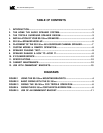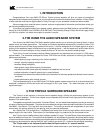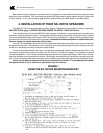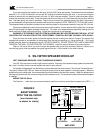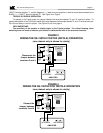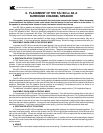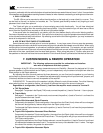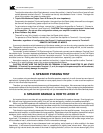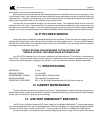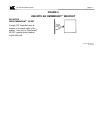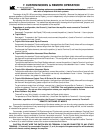
SS-150THX satellite speaker
page 9
To adjust the attenuation of the Dipole element, connect the positive (+) lead to Terminal 3 and insert a 5 watt
resistor between terminals 3 and 4. The resistor can be any value between 2 and 11 ohms. The larger the
value of the resistor, the greater the attenuation.
f. Tripole With Maximum Output From All Drivers (2.4 ohm impedance)
Compared to the standard Tripole configuration, the output from the Dipole (side) drivers will be unchanged,
but there will be significantly greater output from the Direct (front) drivers.
To get maximum output from all drivers, connect the (+) lead from the amplifier to Terminal 1. Connect a
jumper wire between Terminal 1 and Terminal 3. CAUTION: This configuration presents a 2.4 ohm load
to the amplifier. Do not use this configuration unless your amplifier is rated to 2 ohms.
g. Direct Radiator Only Mode
There will be very little (virtually no) output from the Dipole (side) drivers.
To operate as a Direct Radiator, connect the (+) lead from the amplifier to Terminal 3. Use no jumper.
Remember, regardless of configuration, the Ground (-) lead must always connect to Terminal 2.
REMOTE SWITCHING OF MODES
If you want to be able to switch between any of the above modes, you can do so by using a speaker level switch
box. The specific instructions will vary according to the particular switcher you are using and the , so this is section
is intended to be general in nature.
For example, to switch between THX Dipole mode and Tripole mode, connect one wire between Terminal 3 and
the switcher Input. Connect a separate wire between Terminal 4 and one of the switcher outputs. For the THX Dipole
mode, the switcher output connected to Terminal 4 should be turned off. For the Tripole mode, the switcher output
should be turned on. Nothing else should be connected to the switch box, especially your amplifier.
As another example, you can also use a switcher to direct the (+) signal from the amplifier to either Terminal 1
or Terminal 3, to switch between some of the custom modes described above.
CAUTION: DO NOT WIRE THE SWITCH BOX SO TERMINAL 2 CAN BE CONNECTED TO ANY OTHER
TERMINAL. If Terminal 2 is connected to Terminal 1, 3, or 4, the output of the power amplifier will be shorted,
which will almost certainly damage the amplifier.
8. SPEAKER PHASING TEST
In any system using a subwoofer separate from Satellite speakers, especially in multi-channel surround sound
applications, a phasing test must be performed to insure proper phase in the system, in order to achieve optimum
sound in the critical bass frequencies.
Therefore, you must have correct phase among all the speakers in the system. We recommend using a test disc
to compare the phase of the front channels, surround channels, and subwoofer. Test by comparing the phase between
individual channels (starting with the front right and left) until you have established that all units have identical phase.
9. SPEAKER DAMAGE & HOW TO AVOID IT
An important factor to consider with any speaker system is the potential for speaker damage. Even though your
SS-150THXs have high power handling ability, they still can be damaged by relatively low powered amplifiers.
While very few M&K speakers ever need service, the vast majority of those returned are not for manufacturing
defects. Instead, they are returned because they have been overdriven, and almost always because the amplifier used
was driven into clipping distortion. This damage is abuse, and is not necessarily covered under warranty.
This distortion occurs when the demands of the music are greater than the amplifier's power. It can occur at 20
watts with a small amplifier, or at 400 watts with a large amplifier. Regardless, when this happens, the amplifier's output
waveform (which usually looks like a smooth arc) is "clipped" off, exhibiting a flat top instead of the arc.
This flat top contains multiples of the original amplified frequencies, sometimes at higher levels than the original
signal itself. For tweeters, this can be very damaging, as this distortion is well above the audible range, where you
will be unable to hear it, and where the tweeter is more vulnerable to damage.
When an amplifier clips, its sound becomes harsh and grating, and a break-up is often audible in the bass
frequencies. It will become uncomfortable to listen to, compared to a slightly lower volume level. When you are
listening at high volume levels, be aware of the onset of clipping distortion, and turn the volume down slightly if the




